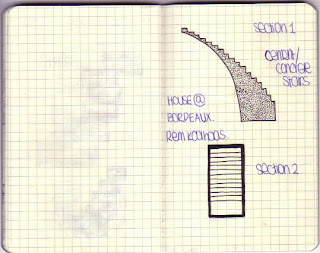Monday, March 30, 2009
36 Custom Textures:
Above Ground

(From left to right)
Top row: Symmetrical, sharp, bling, sticky
Middle row: Flat, shattered, transparent, soft
Bottom row: Oakey, vibrant, jagged, fired
In Between

(From left to right)
Top row: Flowing, contrasting, flexible, electronic
Middle Row: Stitched, colourful, crusty, flaky
Bottom Row: Brittle, Rich, combined, jiggly
Below Ground

(From left to right)
top row: saturated, solid, rocky, deep
middle row: organic, heavy, hard, loose
bottom row: grainy, complex, strong, icy

(From left to right)
Top row: Symmetrical, sharp, bling, sticky
Middle row: Flat, shattered, transparent, soft
Bottom row: Oakey, vibrant, jagged, fired
In Between

(From left to right)
Top row: Flowing, contrasting, flexible, electronic
Middle Row: Stitched, colourful, crusty, flaky
Bottom Row: Brittle, Rich, combined, jiggly
Below Ground

(From left to right)
top row: saturated, solid, rocky, deep
middle row: organic, heavy, hard, loose
bottom row: grainy, complex, strong, icy
Monday, March 23, 2009
"Moffatt's work seeks to confuse and disturb meanings of cultural identification while questioning the authenticity of the presentation by reinforcing its own 'fake' construction."
Moffatt's fantasy work, Adventure Series contained painted backdrops, costumes and models including herself to create a soap opera like drama of doctors, nurses and pilots in a tropical setting.
Moffatt's Portraits explores the idea of 'celebrity' among people in her social circle, including fellow artists and members of her family. In this work, Moffat creates 'glamorized' renderings of their faces using computer technology, repetitive framing and bright colors.
Moffat began taking photographs and then wanted to go further than photography to present her images, so Moffat found this printer in New Jersey who had a huge old-fashioned set-up. He was a commercial printer, and he said he would do the job. Moffat said "It's all by hand, colour after colour, screen after screen, so the pictures have this sort of built up feel: like a pastel, a watercolour. And it's very physical. I wanted the physicality of paint on paper. I wanted it to be sensual."
Her works blur the boundary between photography and film, with characters acting out stories in painted backdrops of the Australian outback.
In her films and photographs, Moffat uses highly choreographed lighting, sound, composition and colour which forms a complex and multi- layered narrative. Most of her work addresses issues such as Indigenous Heritage, race, gender, sexuality and identity.
Moffatt's fantasy work, Adventure Series contained painted backdrops, costumes and models including herself to create a soap opera like drama of doctors, nurses and pilots in a tropical setting.
Moffatt's Portraits explores the idea of 'celebrity' among people in her social circle, including fellow artists and members of her family. In this work, Moffat creates 'glamorized' renderings of their faces using computer technology, repetitive framing and bright colors.
Moffat began taking photographs and then wanted to go further than photography to present her images, so Moffat found this printer in New Jersey who had a huge old-fashioned set-up. He was a commercial printer, and he said he would do the job. Moffat said "It's all by hand, colour after colour, screen after screen, so the pictures have this sort of built up feel: like a pastel, a watercolour. And it's very physical. I wanted the physicality of paint on paper. I wanted it to be sensual."
Her works blur the boundary between photography and film, with characters acting out stories in painted backdrops of the Australian outback.
In her films and photographs, Moffat uses highly choreographed lighting, sound, composition and colour which forms a complex and multi- layered narrative. Most of her work addresses issues such as Indigenous Heritage, race, gender, sexuality and identity.
Sunday, March 22, 2009
Majority of Rosalie Gascoigne's evocative work is centered on a strictly structured arrangement of fundamental shapes such as rectangles and squares within a grid. Gascoigne uses objects she has found over a long period of time and kept until they are suitable to use in an arrangement. She is mostly found using materials such as wood, iron, wire, feathers and yellow retro road signs, which flash and glow in the light.
Through the use of these industrial debris, Gascoigne achieves rhythm and and movement through repetition and patterning. The use of recycled materials in her work conveys a concern for the environment and is evidently a practice of the green movement.
Text is another important element of Gascoigne's work. She would cut up and rearrange the lettering found on the items she would collect in order to create abstract yet evocative grids of letters and word fragments. This text would sometimes allude to the poetry and crosswords she loved.
Gascoigne follows a careful placement with no modifying or altering of the material, which allows the artist to convey a sense of a particular place very accurately.
Through the use of these industrial debris, Gascoigne achieves rhythm and and movement through repetition and patterning. The use of recycled materials in her work conveys a concern for the environment and is evidently a practice of the green movement.
Text is another important element of Gascoigne's work. She would cut up and rearrange the lettering found on the items she would collect in order to create abstract yet evocative grids of letters and word fragments. This text would sometimes allude to the poetry and crosswords she loved.
Gascoigne follows a careful placement with no modifying or altering of the material, which allows the artist to convey a sense of a particular place very accurately.
Saturday, March 21, 2009
Thursday, March 19, 2009
Four Sets of Stairs.
18 Sections.
Saturday, March 7, 2009
Great Architecture.
My three Pieces of Creative Work.
Subscribe to:
Comments (Atom)



































